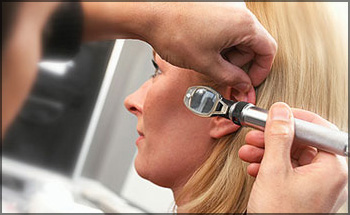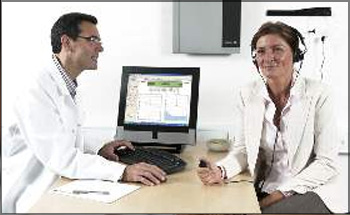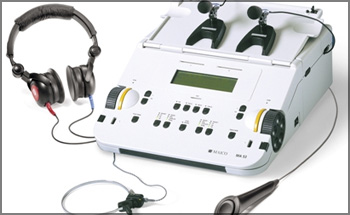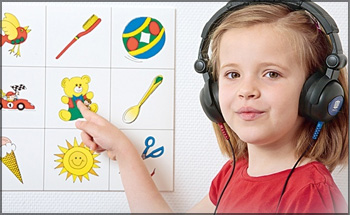Shine Speech and Hearing |
Audiological & Communicational
Rehabilitation Center |
|
 |
|
|
| |
Audiological testing |
 |
| |
1 Pure tone Audiometry
Pure tone audiometry (PTA) is a very important hearing test. It is used to identify hearing threshold levels of an individual. It is a test which enables the determination of the degree, type and configuration of hearing loss. It is therefore a key hearing test which provides the basis for diagnosis and management of the loss of hearing. PTA is a subjective, behavioural measurement of hearing threshold. One reason for this is because; through the test patient response to pure tone stimuli determines its effectiveness. Therefore, PTA is used mostly on adults. Children who are not old enough may be unable to fully cooperate with the test procedure. |
| |
|
| |
2 Tympanometry (Impedance Audiometry)
The primary purpose of impedance audiometry is to determine the status of the tympanic membrane and middle ear via tympanometry. The secondary purpose of this test is to evaluate acoustic reflex pathways, which include cranial nerves (CN) VII and VIII and the auditory brainstem. This test cannot be used to directly assess auditory sensitivity, although results are interpreted in conjunction with other threshold measures.
Acoustic immittance is a measurement of energy or air pressure flow, which involves the ear canal, eardrum, ossicular chain, tensor tympani, stapedius muscle, cochlea, CNs VII and VIII, and the brainstem. Mass, mobility, and resistance of the outer and middle ear systems affect this test. The reciprocal of acoustic immittance is acoustic impedance. Particularly in earlier years, these measurements were performed in impedance rather than immittance measures; thus, the term impedance audiometry is sometimes used. |
| |
|
| |
3Reflexometry
Audio-Reflexometry measures the level of hearing through the observation of involuntary responses resulting from acoustic stimulation. The stapedius muscles get contracted when elicited by an acoustically loud sound. This is called acoustic reflex. Acoustic reflex results draw a major contribution to differential diagnosis and should be part of every basic audiological evaluation. They can provide information about the type and degree of hearing loss. An acoustic stimulation to one ear causes reflex contractions in both ears, and therefore we measure both the ipsilateral and contra lateral reflex pathways. |
| |
|
| |
4Eustachian tube function test
The eustachian tube (pharyngotympanic tube) connects the middle ear cavity with the nasopharynx. It aerates the middle ear system and clears mucus from the middle ear into the nasopharynx. Opening and closing functions of the eustachian tube are physiologically and pathologically important. Normal opening of the eustachian tube equalizes atmospheric pressure in the middle ear; closing of the eustachian tube protects the middle ear from unwanted pressure fluctuations and loud sounds. Mucociliary clearance drains mucus away from the middle ear into the nasopharynx, thus preventing infection from ascending to the middle ear.
Abnormal or impaired eustachian tube functions (ie, impaired opening or closing, defective mucociliary clearance) may cause pathological changes in the middle ear. This in turn can lead to hearing loss and other complications of otitis media. These pathological changes include recurrent acute otitis media and otitis media with effusion. Chronic retraction of the tympanic membrane may also lead to middle ear atelectasis and subsequent adhesive otitis media. A retraction pocket of the tympanic membrane secondary to chronic eustachian tube dysfunction may eventually evolve into cholesteatoma and potentially serious complications.
A functional and patent eustachian tube is necessary for ideal middle ear sound mechanics. A fully patent eustachian tube may not necessarily have perfect functioning, as is the case with the patulous eustachian tube or with mucociliary abnormalities. Testing of both eustachian tube patency and function are therefore important. |
| |
|
| |
5Special tests (SISI, TDT, ABLB)
In the earlier years differential diagnosis for audiometric test results were limited. The first audiometric test battery came into existence with the inclusion of speech tests in 1924. “Supra-threshold” audiometric tests were reported in 1930’s.

With the pure tone Audiogram, comparison of air and bone conduction results assisted in the diagnosis of conductive, sensorineural and mixed hearing impairment. Speech tests alone were of little diagnostic value. So the special audiometric test to differentiate cochlear pathology vs retro-cochlear pathology came into existence.
Indications for the Special Audiometric Test are sensori-neural hearing loss associated with the symptoms like giddiness, tinnitus, vomiting, nausea, positional vertigo, imbalance etc.
I) TDT : (Tone Decay Test)
 TDT is the most commonly used tests because the test can be reliably carried out on any pure tone audiometer and helps in diagnosing neural lesions like acoustic neuroma.
TDT is the most commonly used tests because the test can be reliably carried out on any pure tone audiometer and helps in diagnosing neural lesions like acoustic neuroma.
In TDT a sustained air conducted ear tone is presented while assessment of resulting changes in auditory threshold is made.
There are two commonly used methods:
1. Carhart’s TD Test
2. Rosenberg’s TD Test.
II) SISI : (Short Increment Sensitivity Index)
 The SISI test determines the capacity of a patient to detect a brief 1 dB increment at a 20 dB supra-threshold tone (called carrier tone) in various frequencies (preferably at 1000 Hz and 4000 Hz). This increase in the intensity of the carrier tone may be varied from 6 dB to 1 dB, Twenty such 1 dB increments are presented in the test ear and patient is asked to count how many of these 1 dB increments he could correctly identify. This multiplied by 5, gives the percentages SISI score.
The SISI test determines the capacity of a patient to detect a brief 1 dB increment at a 20 dB supra-threshold tone (called carrier tone) in various frequencies (preferably at 1000 Hz and 4000 Hz). This increase in the intensity of the carrier tone may be varied from 6 dB to 1 dB, Twenty such 1 dB increments are presented in the test ear and patient is asked to count how many of these 1 dB increments he could correctly identify. This multiplied by 5, gives the percentages SISI score.
Though SISI test is useful in distinguishing between cochlear and retro-cochlear lesions, it is not entirely foolproof and has its own limitations. So it should be used as a part of audiological test battery and the results must be interpreted in the light of other audiological findings.
 III) ABLB : (Alternate Binaural Loudness Balance) :
III) ABLB : (Alternate Binaural Loudness Balance) :
It is a standard behavioral test for recruitment. A pure tone test is done when there is a threshold difference of > 20 dB between the ears at the test frequency (the better ear is relatively normal).
The purpose of ABLB test is to compare the growth of loudness in the impaired ear with the growth of loudness in the opposite (normal) ear to demonstrate the degree of recruitment.
|
| |
6Speech Audiometry
 Speech audiometry has become a fundamental tool in hearing-loss assessment. In conjunction with pure-tone audiometry, it can aid in determining the degree and type of hearing loss. Speech audiometry also provides information regarding discomfort or tolerance to speech stimuli and information on word recognition abilities. Speech audiometry has become a fundamental tool in hearing-loss assessment. In conjunction with pure-tone audiometry, it can aid in determining the degree and type of hearing loss. Speech audiometry also provides information regarding discomfort or tolerance to speech stimuli and information on word recognition abilities.
In addition, information gained by speech audiometry can help determine proper gain and maximum output of hearing aids and other amplifying devices for patients with significant hearing losses and help assess how well they hear in noise. Speech audiometry also facilitates audiological rehabilitation management.
|
| |
|
|
|